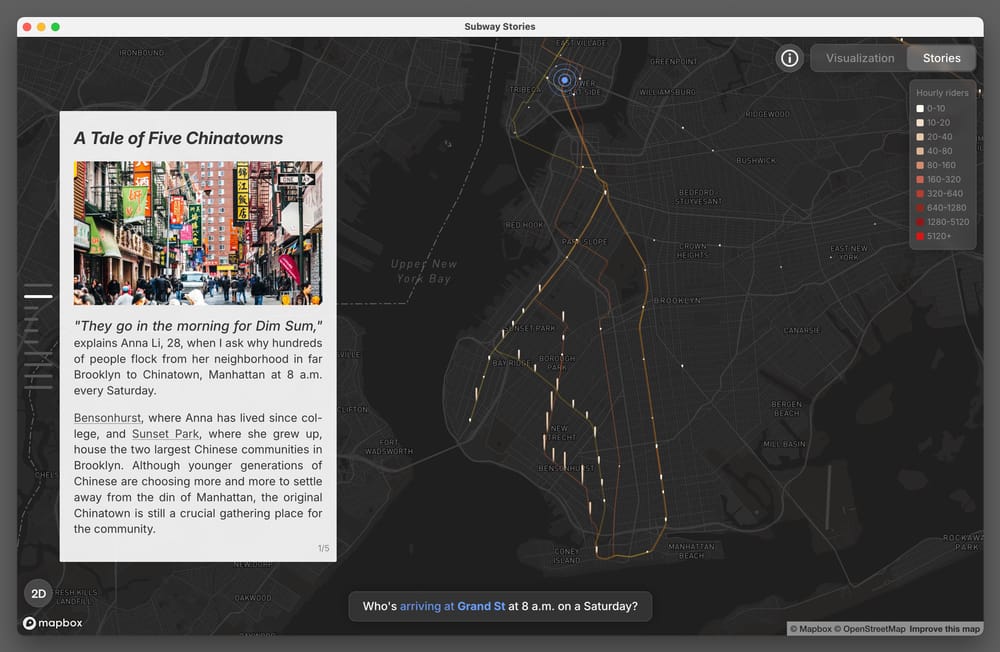Last Chance to Catch NYC's Holiday Notalgia Train
We met the voices of the NYC subway on our nostalgia ride this weekend!

Find out what a year's worth of subway rides looks like!

On November 4th, the New York City subway welcomed its billionth rider of the year—10 days before the same milestone was hit in 2023. The honor went to Sir Michael Carrasquillo of Prospect Heights, Brooklyn. If we followed Carrasquillo's route, we'd likely learn a lot about his life, from where he works and lives, to where he likes to shop and eat. What could we learn about life in New York City from looking at all one billion subway rides?
A team of three New Yorkers set out to answer this question by visualizing the MTA’s public ridership dataset. The team of software developer Jediah Katz, data analyst Marc Zitelli, and designer Julia Han transformed that data into Subway Stories, an interactive map that "reveals previously hidden patterns in how New Yorkers move through their city."
Subway Stories was born out of the MTA's inaugural Open Data Challenge, a competition to expand public engagement with the agency’s ridership data. "The MTA contest challenged us to use any of their public data in a creative and useful way. The dataset we chose to focus on, the origin-destination data, seemed interesting and powerful because instead of just telling us which areas are busy, it actually reveals connections between faraway neighborhoods," Jediah Katz told Untapped New York, "Also, it's a new dataset, so there's lots of insights that nobody has explored yet."
"We wanted our readers to understand that these aren’t just points on a map," Katz continues, "they’re people with their own unique story. So we created the stories which are really the soul of the project."
The project features five reported stories that reveal the human element behind the data. For example, in “A Tale of Five Chinatowns,” we uncover the cultural connection between Bensonhurst and Lower Manhattan.“The Weekend Shift” examines how gentrification has impacted rush hour traffic. In "Nightlife Along the L," the team interpreted data on arrivals after 11 pm to see where young New Yorkers like to hang out after dark.

"We usually started with a question or a story in mind and then investigated it in the data, but occasionally we’d notice a trend in the data, and a story would follow from there," Katz says about how the team chose which stories to focus on. And the data didn't always show what they expected.
"Probably the most surprising thing I learned was just how many people commute into the city every day. It sounds obvious, but if you’re a local who mostly hangs out with other locals, it’s not always something you think about. About 20% of the city’s workers are actually coming from out of town."
The map is easy to navigate and visually stunning. The subway lines glow in different colors against a dark background as hourly ridership at each station is illustrated by towering bars you can view in 3D or 2D. "One project that really inspired us was Justin Fung’s Manhattan Population Explorer from 2018," Julia Han shares, "That was pioneering work in telling a story over a map of NYC. We wanted to bring that same format to a more powerful dataset. Compared to that project, though, we wanted to bring in a human element and also include the outer boroughs, which are obviously such a major part of New York City."
"As for the interface, since the map is definitely the focal point, we took a more minimalist approach by implementing translucent control panels that wouldn’t distract from it. We incorporated both 2D and 3D viewing options to help users navigate the visualization more easily and pick out individual stations during busy hours when the map gets cluttered," says Han. Using the control panels, viewers can choose a specific day, time, and station to view data on arrivals or departures.
As New York City and our ridership habits continue to change and evolve, so will Subway Stories. "Since we started working on this project, the MTA added the years 2020 through 2022, which is really exciting," says Katz, "That means we can show trends over time. For example, I feel personally that late-night dining is not where it was before Covid. Now we can actually investigate that. So we’re going to add those past years to the project soon."
"I hope people learn something they didn’t know before about the flow of public transportation traffic in the city, hopefully giving them some insight into the lives of members of a group they may not personally be a part of," says Marc Zitelli, "I hope that people can use the tool to explore their own curiosity and discover their own stories. Understanding where different people go and for what reasons helps us all to understand each other just a little bit more."
The team encourages you to add to New York City's narrative by submitting your own Subway Story here!
Subscribe to our newsletter